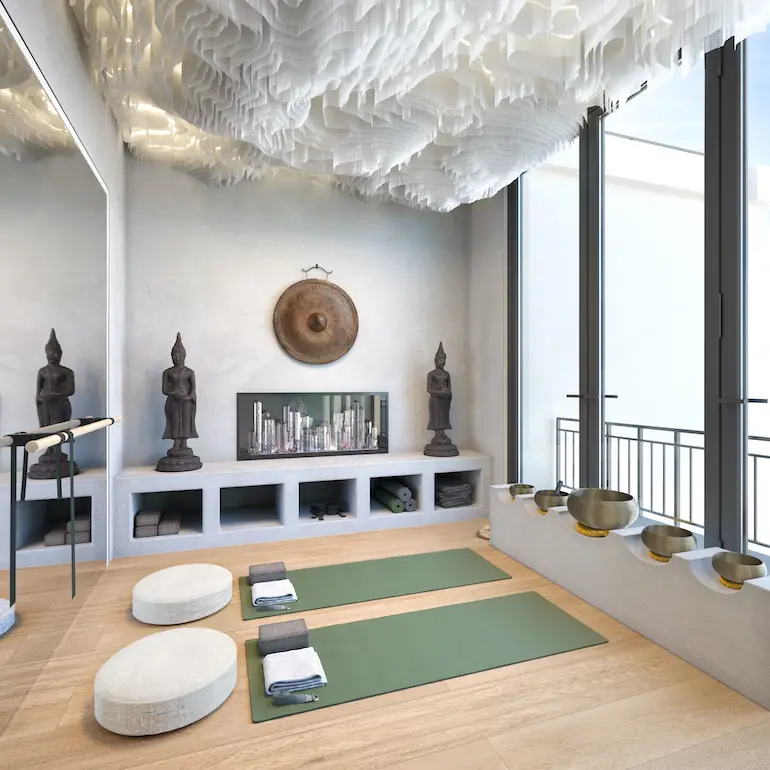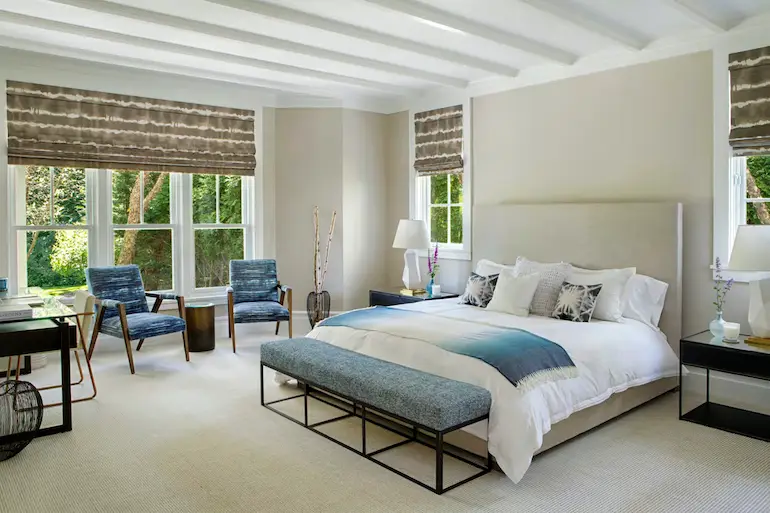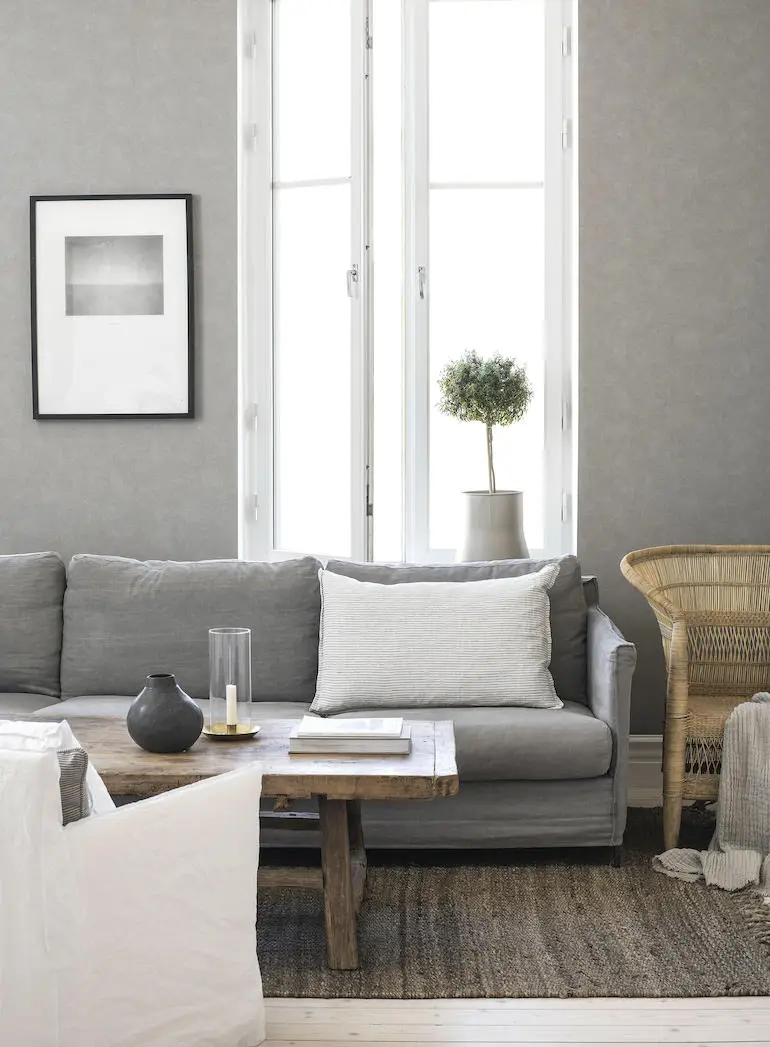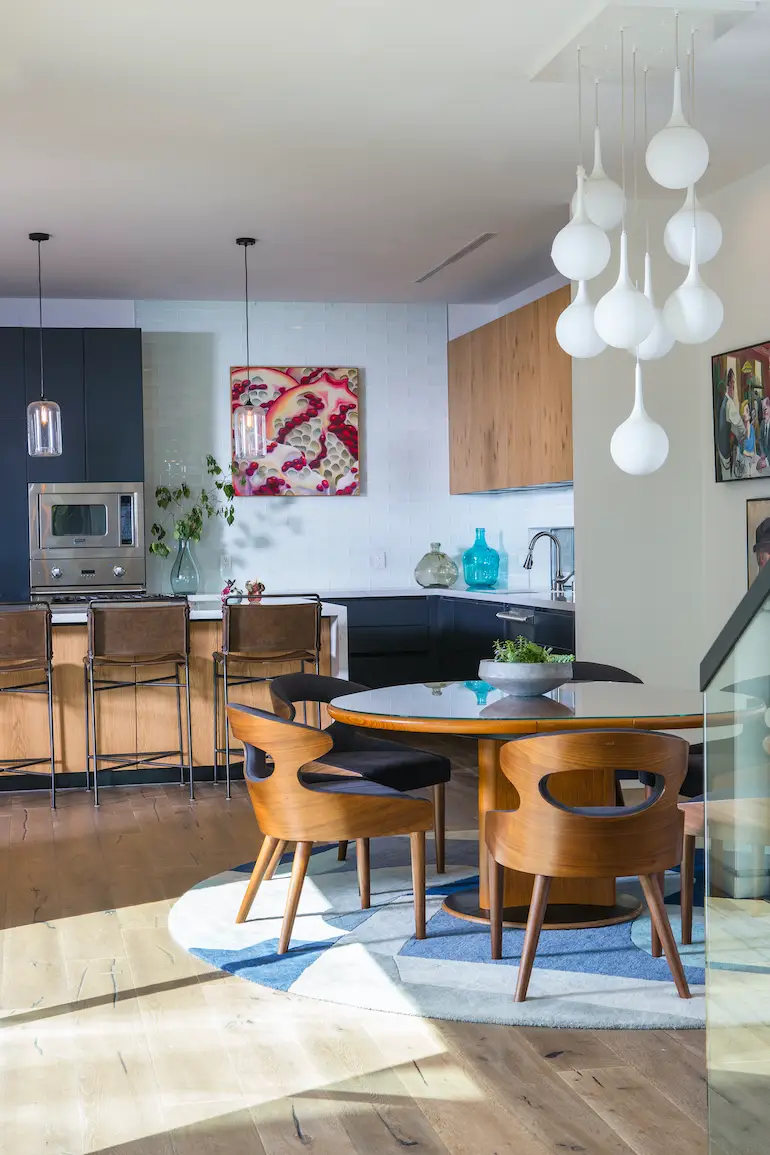Everyone strives for a beautiful home—even more so these days, when we are spending so much time in our personal spaces. Our homes can not only look great, but also lift our spirits and enhance our wellbeing. We asked a panel of design pros for some easy decorating ideas to create a happier, healthier home.
CARVE OUT A PRIVATE SPACE

At the 2021 San Francisco Decorator Showcase, which took place virtually and raised money for the financial aid program at San Francisco University High School, design duo Eva Muller Bradley and Alicia Cheung Lichtenstein of Studio HEIMAT presented a rendering of a room for mindfulness, including meditation, yoga and pilates practices.
Titled “Shoshin,” the word for “beginner’s mind” in Zen Buddhism, the space was intended to calm individuals who enter and open their spirits to new ideas and possibilities. The decor included a neutral color palette, oak flooring, waves of filmy fabric hung from the ceiling and a chorus of Tibetan singing bowls.
“With Covid-19 and working from home, the lines have blurred much more between work spaces and home spaces,” Lichtenstein says. “It’s more important than ever to find ways to mentally keep them apart.”
If space for a personal retreat is limited, designate a corner or sunlit window where you can establish a regular practice of meditation, yoga or even just reading a book. Declare it an electronics-free zone.
“Don’t overdo it with a bunch of little accessories or vibrant colors,” Bradley warns. “Those things are more energetic than soothing.” Instead, opt for a high-quality yoga mat or rug, a cozy floor pillow or blanket, a plant and perhaps one meaningful object that can serve as a focal point.
GET A GREAT NIGHT’S SLEEP

Dress your bed in layers to maximize restful, comfortable sleep, says Jessica Shaw, interior design director at the Turett Collaborative in New York City.
For cold months, a chunky knit, faux fur or wool blanket provides style and warmth. When the temps are warmer, a thin fabric runner at the foot of the bed achieves the look of layering without bulk. A great classic choice anytime is a cashmere throw.
Should you snuggle under a weighted blanket? It’s a personal decision, Shaw says. If you associate weight with comfort, it might help you snooze. But the heavier the blanket, the more costly and cumbersome it will be.
“As an alternative, a coverlet on top of your normal bedding adds weight and can also bring personality to the space,” she says.
If it touches your body—bed linens, a desk chair—be sure to invest in an item that’s top-quality, the Studio Heimat designers advise.
CONNECT TO NATURE

“Biophilic design” builds on the connection between humans and nature and has been shown to support cognitive function, physical health and psychological wellbeing.
“On a simplistic level, this can be achieved through bringing houseplants into a space or painting the walls green, but there are lots of other ways to increase the connection,” says Joanna Thornhill, a London-based interiors stylist and author of 2021 book “The New Mindful Home.”
Designs that depict nature, such as a painting of a tree or a wallpaper with a floral motif, can be calming influences. “Bring in facsimiles of nature if your access to the real deal is limited,” Thornhill says.
Designer Rowena Finegan of Eco-Terric, a design showroom in Sausalito, California that specializes in healthy interiors, says look for organic cotton, linen, wool, hemp and wood certified by the Forest Stewardship Council.
“When you incorporate non-toxic furnishings, you gradually clean up the air quality in your home,” she observes.
COLOR WITH INTENTION

We think of blues and greens as calming colors, but tone and tint, where it is used and what it’s paired with are also key.
“It’s really important to tune in with yourself and consider what support you need from your space,” Thornhill says.
You might want your bedroom to exude a calming feel, for example, but in your kitchen or dining area, something more fiery might work, to spark family interaction. In a home workspace, a color that boosts creativity—purple is a great example—is a strategic choice.
For the least mental impact, stick to a monochromatic palettes, Thornhill adds.
LIGHT UP YOUR WORLD

Our circadian rhythms naturally follow the patterns of the sun, but modern-day schedules don’t allow us to live that way. A layered lighting plan can trick us into thinking we are, says Courtney Porter, a Los Angeles-based interior designer and co-author of “Green Interior Design: The Guide to Sustainable High Style.”
“Include different types of lighting—overhead lighting, mood lighting, task lighting—that you can adjust to the brightness of day and night,” she says. “Put dimmers and LED bulbs on everything.”
Light therapy lamps, which mimic sunlight, can boost your mood and energy in the winter, when daylight is scarce, or when you have a pre-dawn wakeup call.
Many window treatments should be layered: sheers to diffuse bright sunlight combined with opaque draperies for blocking out light.
And of course, whenever possible, open your windows to welcome in natural daylight and allow breezes of fresh air to flow through your space, Porter says.
More from SPACES:
- This Big Sky, Montana Home Is Marvelously ‘Mountain Modern’
- A Luxe Remodel Celebrates the Views From This Marin County Hillside Home
- ’80s Chic: This Home’s Idiosyncratic Blend of Art and Pattern Was Partly Inspired by “Home Alone”
 Pamela Dittmer McKuen is an award-winning Chicago-based freelance features journalist who specializes in home, design and travel. She has dual passions for dark chocolate and cats.
Pamela Dittmer McKuen is an award-winning Chicago-based freelance features journalist who specializes in home, design and travel. She has dual passions for dark chocolate and cats.
